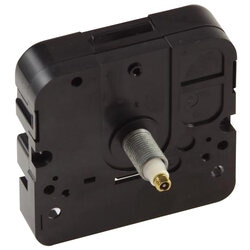Clock Parts
Recognizing Clock Movements Operations
A clock movement is that which makes the watch job, or function. The clock electric motor (likewise known as a movement in trade jargon) keeps an eye on how many pulses are being given off by a quartz crystal, therefore computing where the hands require to be placed. The fundamental operation of this device is thus conceptually basic, however the function set built on it can be potentially substantial and also exotic.
In olden days a clock electric motor was purely mechanical. A snugly coiled spring or a dangling weight furnished adequate rotational torque to turn a flywheel, as well as different kinds of regulators controlled its rate. Pendulums, escapements, as well as equipment networks guaranteed precision of hand placement against an adjusted dial.
In today's globe, the mechanical way of running clocks has actually passed the wayside, supplanted by electronic methods. Putting a voltage differential throughout a quartz crystal triggers it to give off pulses at a high and monotonous frequency, and accumulating the pulse count causes a record of elapsed time. Digital registers shop the matters, and also software application transforms the instant record into hrs, minutes, and seconds.
This, then, is just how the contemporary temporal movement works, at the very least on a standard degree, obviating the demand for (fairly) cumbersome flywheels, pendulums, and also networks of gears. However lack of mass also allows for much advancement, in terms of performance as well as expanded attribute sets, in that software application implementation is comparatively quick. Timekeeping can be prolonged in many methods, as well as novelty functions are easy to add.
Extended timekeeping can be found in the kind of longer-than-normal cycles before every little thing resets. For example, we are made use of to seeing clocks that reset every twelve hrs (no difference between AM and also PM), yet there are electric motors that reset every 24 hours, or every week, or each month. Such expansions normally require a similarly calibrated dial, as well as typically an added hand is needed to reveal the day of the week or the date of the month.
An additional timekeeping difference is the presence or lack of a used; some prefer the continuous ticking, while others favor no diversion. However, it is feasible to have a clock electric motor that sustains a second hand that is silent as well as continually sweeping across the dial. So, the choices are for a second hand that (a) ticks and jerks every second, (b) continuously and also silently sweeps, or (c) is lacking completely.
A special sort of time expansion relates to revealing tidal details; the trends are cyclical, yet derived primarily from the lunar cycle equating to 1 day and also 50 minutes. Thus, it is straightforward to program a wrist watch electric motor to reset itself according to the lunar schedule, with high tides and also low tides showed precisely. Certainly, the motor should be initialized correctly, taking regional conditions into consideration.
Non-cyclical weather condition sensations can additionally be presented utilizing a clock movement, though periodicity of procedure is replaced with real-time conversion of input from sensors. Here, the dial is truly straight, not circular, and also a solitary hand arrays between the two extremes according to the value signed up on the sensing unit. It is common to find electric motors that show temperature level, humidity, and/or barometric pressure in this manner.
Uniqueness features are additionally quickly set right into clock movements. Playing chips in among the typical tunes (e.g., Westminster) is easily offered, with or without an hour count following. Pendulums, no more important mechanical components for watch operation, however offer interest as aesthetic oscillations.
Simply put, the old-style clocks (mantle, cuckoo, grandfather, etc) are quickly duplicated today electronically, tweaking basic movement operations and also applying a lot more complex functionality in software program. There is practically nothing that can not be accomplished through correct understanding of clock movement operations.

Comments
Post a Comment